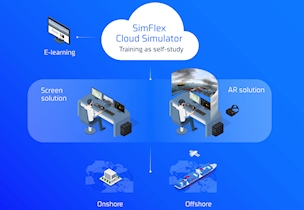Remote extended reality simulator connects trainees and instructors across oceans in real-time
Barranquilla Pilots use remote XR training to reduce costs and emissions, while ensuring certified maritime simulation with real-time instruction from Denmark.
Rethinking maritime training
Around the world, pilot organisations are under pressure to modernise training without compromising safety, certification, or continuity. Traditional simulation centres are a mainstay, but travel-intensive models have come under scrutiny both for their cost, and environmental impact. In Colombia, the Barranquilla Pilots organisation with support from FORCE Technology, have set a new benchmark for remote, high-fidelity maritime simulation training.
It's common for marine pilots to travel internationally in order to attend simulator training, which can disrupt operations, increase costs, and produce carbon emissions from air travel. For a pilot station that must remain ready around the clock, this model creats logistical strain and rising costs. There was a clear need to bring the training closer to home.
Remote simulation - a game changer
The solution was the innovative SimFlex XR remote extended reality simulator. The pilot station in Barranquilla was equipped with a three-screen console, role-based interaction stations, and Virtual Reality (VR) headset integration, which was later upgraded to the advanced Varjo XR-4 system for higher fidelity which better integrates the real hardware in the virtual environment. The setup allows pilots to conduct immersive, certified training exercises without ever leaving their facility. And, with the XR-4's human-eye resolution and advanced optics, the experience is as close to being on the bridge as current technology allows.
During training, the pilot wears the XR headset and is placed on a virtual ship’s bridge. A team member playing the role of the ship’s captain operates the control console (engines and helm), and two other team members play the roles of radar operator and officer of the watch. The XR system displays a full 360-degree virtual bridge environment, while the three screens show synchronised views for the additional crew. In Denmark, the instructor interacts in real time by monitoring the Pilot’s commands, the interaction between team members, and implementing adjustments to the scenario to increase the level of complexity.
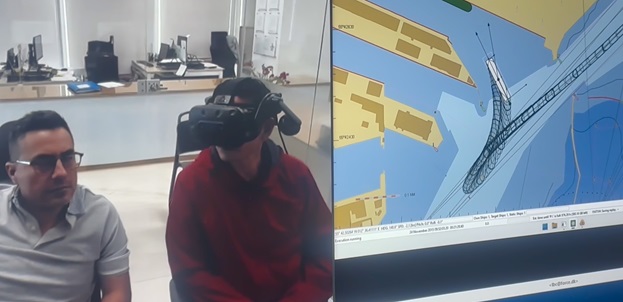
Full team training across borders
The Barranquilla Pilots also use the XR simulator for dedicated, non-mandatory Bridge Resource & Team Management (BRM-BTM) training. This is the first time such simulator training has been remotely delivered succesfully, with FORCE Technology delivering lectures, role play, case analysis, and simulator exercises from Denmark to teams at the Barranquilla Pilots.
The course feature demanding scenarios where participants must demonstrate their understanding and ability to apply BRM/BTM principles. Each remote simulation training session starts in Denmark, where the instructor selects the appropriate scenario and connects to the pilot station in Barranquilla. The pilot dons the XR headset and assumes the role of pilot-in-command while the other team members take over their roles.
Throughout the session, the instructor in Denmark follows each command and movement via video, audio and telemetry. Using a tablet interface and real-time voice monitoring he can assess diverse criteria, such as cooperation between team members and their decision-making ability as well as the team’s shared situational awareness and adherence to best practices.
The training follows a rotational model: over the course of four days, each of the four participants cycles through all main roles. This approach ensures holistic competence, as each pilot gains experience both in command and in supporting functions. The outcome is a certified, standards-compliant course that mirrors the value of in-person training without the travel burden.
Quantifying the benefits: Time, cost, and carbon
The pilots can now underake advanced shiphandling training at their premises, using local scenarios along the Magdalena River, while the instructor runs the session including exercises and debriefing remotely from Denmark (in Spanish). A combination of morning theory and afternoon simulation training is the perfect format to ensure maximum transfer of knowledge into skills. It also means that pilots are available after training to continue with the normal duties at the pilot station, if needed. Some pilots also use the opportunity of having the simulator in the office to repeat and gain extra confidence.
The operational benefits are immediate and tangible. By eliminating the need for traveling long-distance for training, important savings are obtained such as time, use of resources, and travel costs (e.g., flights and lodging), while ensuring pilots are home and available for harbour operations. The remote XR setup requires less than half the investment per session compared to traditional centre-based training. Incorporating the equipment costs in Barranquilla, the pilots reached the break-even point after only two sessions.
Subsequent sessions have generated clear savings, with the return on investment continuing to grow as more training is delivered through the remote system. Further saving can be made if the the system is applied to other applications. For instance, the same installation could be used for minor port engineering studies, without the need to pay for new equipment or to attend a simulation centre in Denmark (or anywhere in the world).
The environmental impact is equally positive. Early comparisons show that each remote session reduces emissions by over 90% when compared to conventional, travel-based training. This includes the one-time impact of producing the XR equipment itself, which is quickly outweighed by repeated use.
Perhaps most critically, the remote XR model opens the door to increased participation, enabling more pilots to be trained without added burden. It also avoids time-zone fatigue and weekend travel, allowing pilots to remain on-call at their home port. This not only reduces operational disruption but also enhances quality of life. Pilots spend more time with their families and less time in transit.
Stepping up to XR-4: A professional-grade leap forward
While their remote training system has been operational since July 2023, in Q2 2025, the Barranquilla pilots became among the first to adopt the Varjo XR-4 headset, a professional-grade XR device purpose-built for industrial simulation. With 33 pixels-per-degree visual fidelity, 120° x 105° field of view, integrated LiDAR depth sensing, and inside-out tracking, the XR-4 delivers a level of immersion and precision unmatched in commercial VR. No external base stations are needed, reducing complexity and improving flexibility in confined training spaces.
The future of remote maritime training
With significant cost and logistics benefits, and with the XR headset, the Barranquilla Pilot's experience proves that remote XR training is not just an alternative, but an upgrade. With international instructors, real-time feedback, and seamless certification compliance, remote XR simulation has reached maturity. As pilot organisations globally assess their training strategies, the Barranquilla Pilot case offers a repeatable blueprint for modernisation. By adopting cutting-edge XR tools and a resilient course delivery model, FORCE Technology and its customers are redefining what maritime training can be; connected, compliant, and with a lower carbon footprint.
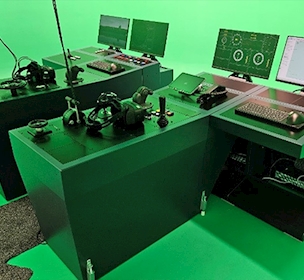
SimFlex XR Full Mission Bridge simulator for training
/Service
Combining physical and virtual environments for cost-effective and immersive maritime training
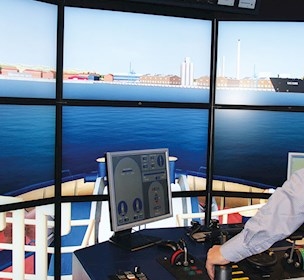
Simulator based navigation training
/Service
Our training is based on many years of navigational experience and the best pedagogical tools
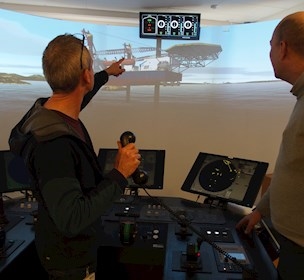
Ship and port models for simulators
/Service
Visual ship and port models are developed and built to create a realistic virtual environment.


